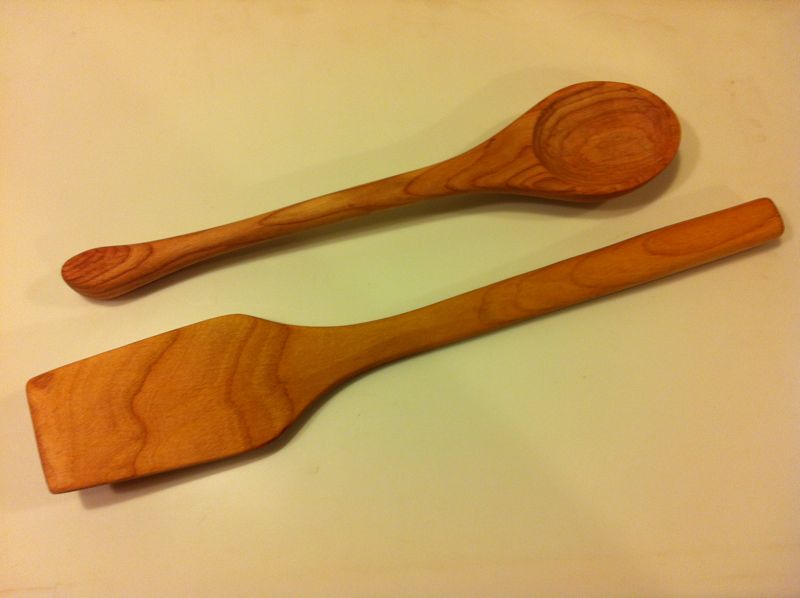I had two excellent “there’s a tool for that” moments this past weekend.
First, as a friend and I were working on his workbench, made from old hunks of bowling alley, we came across a screw that’d broken off in the wood. With nothing to grip, it would’ve taken some serious digging around (and damaging the wood top more than necessary) to get the screw out. Fortunately, we had a screw extractor set handy, and in just a couple minutes were back on track.
Second, that same friend was helping me debug an issue I was having with the robot arm, namely when I tried to have it draw a square, it would actually draw a parallelogram. It turned out I needed to calibrate the motor encoder-to-joint angle conversion, and he suggested using this digital angle gauge. It worked like a charm (and I’m looking forward to using it in the woodshop as well), and now it’s drawing perfect squares and well on its way to becoming bartender.
posted October 17, 2012 – 11:05 am
I posted some photos of a few small woodworking projects I’ve turned out recently, including this spoon and spatula I made as a wedding gift for Mark & Lina
Dina and I were out in Montana this past weekend to celebrate their nuptials, and we really enjoyed our time near Big Sky. It certainly helped that we were surrounded by a bevvy of great people, but the setting didn’t hurt, either. We were pretty far out into the middle of nowhere, in the Gallatin Canyon with no cell phone reception but a very clear night sky. In a magical moment Saturday evening, we walked out of the party venue to see the Milky Way stretching across the sky. Somebody said “Wouldn’t it be great to see a shooting star,” and not two minutes later, as we all gaped at the stars, the biggest, brightest meteor I’ve ever seen streaked down towards the horizon for a few seconds before fracturing into pieces and fading away.
posted October 9, 2012 – 10:31 pm
I’ve talked a bit about Kickstarter in the past, and I also have sunk a bit of money into stuff there. In Kickstarter lingo, I’ve “backed” 9 projects. Recently, they’ve initiated a bit of a campaign — see here and here — to address what apparently is a rash of unfulfilled (or at least delayed) projects, but I think they missed the mark, by a pretty wide margin. The overall message (and in fact, the title of one of their posts on the matter) is that Kickstarter is not a store, but I beg to differ. Kickstarter is definitely a store, just not the kind people are used to, and therein lies the problem.
Let’s start out with what Kickstarter isn’t. Kickstarter is not an investment platform. No one who backs projects gets any sort of stock or other compensation if the companies behind those projects are successful. Kickstarter is also not charity. It’s actually explicitly disallowed in their rules; you have to give people something if they back your project. So I don’t get an ownership stake in the companies for my money, and I do get some thing (or service, I suppose) — that sounds an awful lot like a store… So what’s different?
Well, nothing is in stock, for starters, because it hasn’t been made yet. And the pictures of the goods, well, they might not be 100% accurate, because they might still be in development. And, in fact, if you read the fine print carefully, Kickstarter isn’t guaranteeing that whatever you back will ever ship. (They did recently add language to clarify that creators must refund money if they can’t produce the goods.) Sounds like a pretty lousy store, right?
Let’s look for a minute at things from the point of view of someone creating a product. Historically, there has been a big price gap between producing things in small numbers and mass production. And to bridge that gap, to ramp up production, companies had to come up with a pretty hefty amount of money to cover a variety of upfront costs. They didn’t get to recoup their investment until they sold a decent percentage of the goods. Kickstarter is basically a way to turn this process around, for creators to take pre-orders and collect money upfront. Projects only move forward if they can get enough people signed on to cover the costs (if not enough people buy in, everyone gets their money back). This is what people are talking about when they call Kickstarter revolutionary.
I think it’ll be interesting to see how much the culture and kind of projects posted on Kickstarter change as a result of these new rules. My gut feeling is that they make it much harder for creators (and ultimately Kickstarter) to make money, and trying to disguise what their site really is will be detrimental in the long run.
posted October 9, 2012 – 8:37 pm
